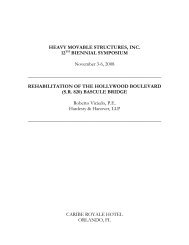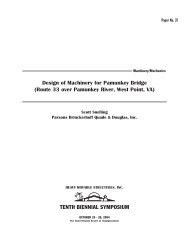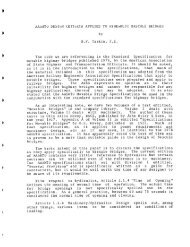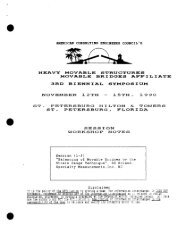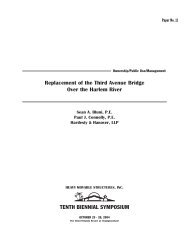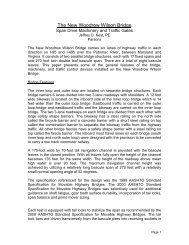Safety in Hydraulic Cylinder Lifting Systems - Heavy Movable ...
Safety in Hydraulic Cylinder Lifting Systems - Heavy Movable ...
Safety in Hydraulic Cylinder Lifting Systems - Heavy Movable ...
You also want an ePaper? Increase the reach of your titles
YUMPU automatically turns print PDFs into web optimized ePapers that Google loves.
2. Qual3ication %ests of new s~wvknq technolorn<br />
In l<strong>in</strong>e our IS0 96101 procedures for a conbotled produaon ail coat<strong>in</strong>gs are quahmed. The tocsBloMng<br />
qualifimgon tests are pedomed:<br />
e bend<strong>in</strong>g test<br />
@salt spray test<br />
*scratch and wear test<br />
eseaf test<br />
.chemical exposure test<br />
The tests and results as men%oned below is atso applicable on the rod coat<strong>in</strong>g as devefoped for bridge<br />
cyl<strong>in</strong>ders.<br />
2.1. Bend<strong>in</strong>n te&<br />
Piston rods sf hydraufic cyl<strong>in</strong>ders are always exposed to Bend<strong>in</strong>g. The Brst step <strong>in</strong> ve~wng the<br />
su@abiS@ of the -rod coat& for hydraulic cif<strong>in</strong>ders is the bend<strong>in</strong>g test. For this k t a pktoi rod is bent<br />
us<strong>in</strong>g a hydra~Sic press. The rod supported at both ends &h a ioad <strong>in</strong> the middle (fig. 3). The rod is<br />
bent 18610 times to the yieM of the base matefiai, simuia~ng a cycfic load<strong>in</strong>g. The tested rod is<br />
checked for cracks us<strong>in</strong>g a dye penetrant NDT test (fig. 4). If no cracks or other impe8fecQo~s are<br />
visual, a test sample is taken out ofthe rod from the middie and the undeMde (pull<strong>in</strong>g side) of We rod<br />
for mi~ros~~flc fesb and tikamer tests such as saB spray test<strong>in</strong>g.<br />
%fig. 3 Test Chamber<br />
2.2. Salt spray test<br />
The salt sg3ray test is accord<strong>in</strong>g ASTM G 85 and DIN 50021. After be<strong>in</strong>g bent the samples are<br />
submerged <strong>in</strong> a solu~on of sodium chlo~de w2h a corscentwBon of 50 f 5 g per liter, 4 pH of 3.1 - 3.3<br />
at 23 k 2 "C for a period of 16100 hours. Test<strong>in</strong>g k pedomed at the Mannesmann Research Center <strong>in</strong><br />
Results: no f<strong>in</strong>d<strong>in</strong>gs of corrosion<br />
2.3. Scratch and Wear test<br />
The head and packc<strong>in</strong>g flange of the test cylhder is mod&M Mh a chamMr <strong>in</strong> which abrasbe<br />
pa~des or moM corrosbe fluids can be brought <strong>in</strong>to contact the rod coa%ng.<br />
Tests were pedormed wifh the follow<strong>in</strong>g mate~ais not k<strong>in</strong>g pre-&ressed as welf as pre-stressed ~<br />
a total stroke of over 200 km:<br />
.<br />
o Silver sand with 3.5% saE water soi~PEion<br />
SIC shot blast g& F120 &h 3.5% saR water soiu%on<br />
Al2O3 shot blast gft FZ 3.5% salt water soldtion<br />
Conclusion: Although the hod showed Hongitud<strong>in</strong>ad scratches no leakage or excessive seal wear was<br />
obsesv&.





